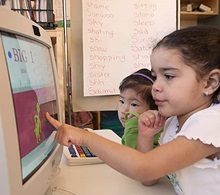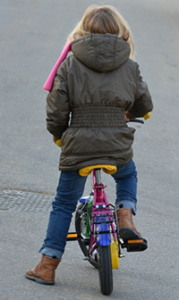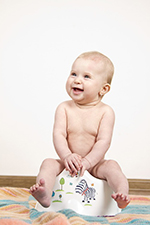 Smart phones, laptops and tablets, oh my! We love all sorts of technologies ourselves but worry about the effect of too much technology on our children. According to a study by Common Sense Media in 2013, the total average screen time for children ages 0-8 years is just under two hours a day. Traditional screen time in front of a TV is still the preferred form of screen time, but not surprisingly, mobile screen time is up. According to the study, 38% of children under two have used a mobile device.
Smart phones, laptops and tablets, oh my! We love all sorts of technologies ourselves but worry about the effect of too much technology on our children. According to a study by Common Sense Media in 2013, the total average screen time for children ages 0-8 years is just under two hours a day. Traditional screen time in front of a TV is still the preferred form of screen time, but not surprisingly, mobile screen time is up. According to the study, 38% of children under two have used a mobile device.
The American Academy of Pediatrics along with the White House Task Force on Childhood Obesity recommend that children under two have no screen time. For children ages 2-5 years, the recommendation for children and technology at home ranges from 1-2 hours per day. The limits are recommended for many reasons, including:
- Sedentary activities like watching TV or playing with smart phone apps limit children’s time to be physically active, important for growing bodies
- Unscreened media content may expose children to food and beverage advertisement for kids, or sexual and violent content.
- Children benefit from playtime learning and through their interactions with other children and adults. The use of technology is often a solitary experience, limiting chances for developing social skills through joint play activities.
- Excessive screen time for children has been linked to irregular sleep, behavioral problems, academic lags, and more.
Passive vs. Interactive Technology: Of course, not all technology experiences are equal. Non-interactive or passive technology like television, movie viewing or streaming media provides no opportunities for hands-on learning, which we know is key for young children’s development. On the other hand, interactive media like ebooks, searching on the internet to solve a problem, or experimenting with educational apps for kids have greater potential than passive experiences. Pre-screening is always recommended with either interactive or non-interactive technology. Intentionality refers to the deliberate choices teachers and parents make about what kind of educational technology might be useful to a particular child’s development. For instance, if your child loves to draw and tell stories, give your child many intentional opportunities to build those skills. If you want your child to also be technologically literate, look for software or apps that allow your child to be a media creator rather than just a game player. Or look for technology that encourages creativity, exploration, pretend play, peer interactions and more.
As with most parenting decisions, you have to examine the recommendations and figure out what is best for your family in the digital age. If having your children under foot while you are trying to prepare dinner results in you losing your patience, then maybe a little video viewing at that time may be a preferred alternative. And of course you are not a “bad parent” if you occasionally go over the above suggested daily limits. Here are a few thoughts to consider when establishing your family’s approach to screen time:
- We can borrow some terms from the field of early childhood education to guide our decision-making about technology and children: developmentally appropriate practice and intentionality. When you consider the development appropriateness of technology for children, you take into account your child’s age, developmental level and individual characteristics. Ask yourself questions like “Is this movie and the violence it includes appropriate for my five-year-old who tends to act out everything he sees?”
- Establish your own family rules for screen time. Consider less screen time during the week and relax a little on weekends.
- Consider an occasional screen free week or day for the whole family to participate.
- To manage children & technology, set a good example yourself.
- Substitute quality time together for screen time. Plan a special outing, play a board game together or let your child choose the activity and follow his/her lead. School-age kids may act like they are not interested, but what children really want and look for is your attention. It is worth persisting.
- When possible, watch TV with your child or interact with the tablet together. Do jumping jacks during commercials or take a break to see who can jump the longest.
- Keep TVs and computers out of children’s bedrooms. When there, research shows there is increased screen time by children.The rapidly changing technological landscape in the digital age has been compared to the historical shift that occurred after the introduction of the printing press, which greatly expanded access to books and printed materials. The impact of technology on children’s lives is constantly changing and as parents and guardians, we are responsible for helping our children maintain healthy technology usage through this important part of their lives.
Digital citizenship in the digital age: Part of our role as parents is also to teach children to be responsible consumers of technology. School-agers can be introduced to the concept of cyber safety and what are appropriate and inappropriate uses of technology. It is also important to explain to children why they have screen time limits.

 One day you’re bringing your new little bundle of joy home from the hospital, the next day they’re off to kindergarten and the day after that they are off to college. Ok, it’s not QUITE that fast but you get the idea – time flies when you’re having fun. Because it won’t be long until your baby is heading to college it’s important that you start saving for that time now. In fact, if you haven’t started planning, preparing and saving by the time your child enters kindergarten, you’re just about five years behind the eight ball.
One day you’re bringing your new little bundle of joy home from the hospital, the next day they’re off to kindergarten and the day after that they are off to college. Ok, it’s not QUITE that fast but you get the idea – time flies when you’re having fun. Because it won’t be long until your baby is heading to college it’s important that you start saving for that time now. In fact, if you haven’t started planning, preparing and saving by the time your child enters kindergarten, you’re just about five years behind the eight ball. With bicycling listed as the second most popular outdoor activity in the US, it only makes sense that sometime in the possibly not-so-distant future you will be looking for a new bike for your child.
With bicycling listed as the second most popular outdoor activity in the US, it only makes sense that sometime in the possibly not-so-distant future you will be looking for a new bike for your child. We face many challenges as parents, but toilet training may feel like one of the more daunting ones. And now that your child seems old enough to begin potty training, you also wonder how potty training works in child care. Relax. Like every other aspect of child care, you and your child’s teacher will work as partners in the process of potty learning. Potty training while in a child care or daycare setting may be easier than it is at home.
We face many challenges as parents, but toilet training may feel like one of the more daunting ones. And now that your child seems old enough to begin potty training, you also wonder how potty training works in child care. Relax. Like every other aspect of child care, you and your child’s teacher will work as partners in the process of potty learning. Potty training while in a child care or daycare setting may be easier than it is at home.